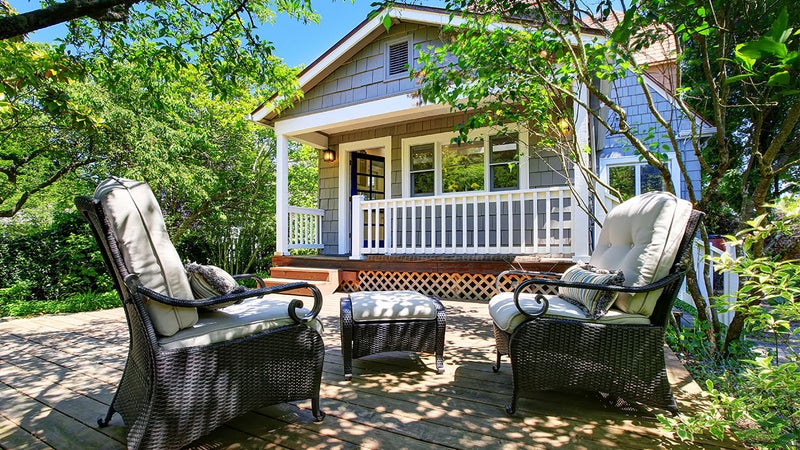What is a HELOC (home equity line of credit)?

The Bankrate promise
At Bankrate we strive to help you make smarter financial decisions. While we adhere to strict , this post may contain references to products from our partners. Here's an explanation for .
Key takeaways
- A home equity line of credit (HELOC) is a variable-rate form of financing that allows you to cash in on the equity you have in your home.
- HELOCs are a revolving line of credit, similar to a credit card — you can borrow what you need, repay it, then borrow again, during a set draw period.
- HELOCs are often used to pay for home improvements, but the funds can go toward any expense.
What is a HELOC?
A HELOC (home equity line of credit) is a revolving form of credit with a variable interest rate, similar to a credit card. The line of credit is tied to the equity in your home. It allows you to borrow and repay funds on an as-needed basis during a specified period of time. After that, you’ll pay back the amount you borrowed in installments.
Your home is the collateral for the line of credit, which means falling behind on payments puts your home at risk of foreclosure.
How does a HELOC work?
When you’re approved for a HELOC, you’ll be given a credit limit based on your available equity in your home. Borrowers can usually tap up to 80 percent of their home’s value (sometimes as much as 85 or 90 percent, depending on lender policy and if they’re very well-qualified), minus outstanding mortgage balances.
During an initial draw period, you can spend the funds using dedicated checks, a draw debit card or online transfer. You’ll need to make monthly interest payments on the amount you borrow, but as you pay back your HELOC, the funds will be replenished. This draw period typically lasts 10 years.
After that, you’ll enter a repayment period, during which you’ll no longer be able to access funds and instead need to repay the principal and any outstanding interest. Most HELOC plans allow you to repay the remaining balance over a period of 10 years to 20 years.
While you’ll often only be on the hook for interest payments during the draw period, you can pay both principal and interest during this phase if you choose. This can help keep your payments manageable when you enter the repayment period.
Why HELOCs are popular in 2024
Though originations are off the 10-year high they hit in 2022, HELOC activity remains well above its pre-pandemic level. Part of the appeal of HELOCs lies in their flexibility – funds can be tapped on an as-needed basis, providing homeowners a cushion against unexpected expenses. Borrowers appreciate the option to take out only what they require and pay interest only on what they use.
Also, while their interest rates have risen, HELOCs still remain less expensive than other forms of consumer debt, like credit cards and personal loans. And, unlike a cash-out refinance — the old go-to way to tap a homeownership stake — HELOCs allow a homeowner to hang onto a mortgage with a low interest rate.
HELOC originations did drop in 2023, due to a rise in their rates — the benchmark $30,000 HELOC even spiked above the psychologically important 10 percent barrier in November and December. But rates retreated in the new year, and Bankrate forecasts they’ll continue to drop throughout 2024, mirroring the Federal Reserve’s anticipated lowering of the primary federal funds rate. “A decline in HELOC rates will be spurred primarily by Fed rate cuts,” says Greg McBride, chief financial analyst at Bankrate. But also, “declining mortgage rates and ongoing economic growth will bring about more introductory rate offers on HELOCs, so the average HELOC rate will be down more substantially.”
A drop in rates would naturally encourage more equity-rich homeowners to turn to HELOCs as a financing tool. And Americans have plenty of equity to tap: As of February 2024, the average mortgage-holder has $193,000 in available home equity funds, according to data analyst Ice Mortgage Technology.
Rates for home equity lines of credit are variable, tied to an interest-rate index that fluctuates. The interest rate on on your HELOC will reflect the performance of that index, reflecting its interest rates, plus an additional markup of several percentage points that your lender tacks on. While some lenders offer fixed-rate HELOCs, these often come with higher interest rates overall.
To secure the lowest possible rate, compare quotes from multiple lenders and keep an eye out for introductory teaser rate promotions. Some lenders may advertise an introductory rate, a temporarily reduced APR for well-qualified borrowers, which could last for six or 12 months or up to a predetermined date. After this period, a higher rate will go into effect.
HELOC requirements
There’s no one-size-fits all set of requirements to qualify for a HELOC. That said, the criteria commonly include:
- Amount of home equity: Lenders typically require homeowners to have at least 15 percent to 20 percent equity in the home.
- Credit score: Homeowners generally need a credit score in the mid-600s — at least — to qualify for a HELOC. If you’re approved with a lower credit score, you’ll likely have a higher interest rate.
- DTI ratio: Many lenders want to see a debt-to-income (DTI) ratio of 43 percent or less. However, certain lenders might approve you with a DTI ratio of up to 50 percent.
How to apply for a HELOC
- Review and strengthen your credit. A strong credit score, ideally in the 700s, will get you the most favorable rate and terms. To improve your credit, make all payments on time — catching up on any past-due ones — and try to settle or at least pay down any outstanding balances. Review your credit report to correct any errors. Do all this several months before you actually apply.
- Find a HELOC lender. Shop around and compare offers. Even a small difference in interest rate can save you thousands in the long run. Learn whether the HELOC lender charges annual maintenance or early closure fees.
- Apply for the HELOC. Depending on your lender, you can do this in several ways: in person, over the phone or online. However you apply, you’ll need to provide your residence history and income and employment information. You’ll also need to verify your identity and give permission for the lender to pull your credit reports.
- Hurry up and wait. The lender will order an appraisal of your home to determine its current value. The appraiser’s assessment of overall home worth determines how much equity you have available, which in turn helps set the size of your line of credit. Your lender might get back to you with a preapproval or an initial decision within days; others require you to wait until the whole underwriting process is done.
How do I access funds with a HELOC?
To access HELOC funds with a HELOC, you can typically use checks, a debit card, or make online transfers from one account to another. The specific methods depend on the lender you choose.
When considering how to use your HELOC, there are a few more details to keep in mind:
- Minimum draw requirements and potential fees: Some HELOCs mandate minimum withdrawals, impose transaction fees each time you access funds or charge an annual maintenance fee. It’s wise to clarify these terms with your lender beforehand.
- Withdrawals: To manage your finances effectively, withdraw only the amount you need and make timely payments. This helps you minimize interest charges and can positively influence your credit score.
- Repaying the principal: Many HELOCs allow you to make minimal, interest-only repayments during the draw period. Tempting as that might be, making principal payments — if you’re able to — can reduce the balance you’ll owe in the repayment period.
- Early payoff penalties: Conversely, if you pay off your entire and close the HELOC early — within the first two or three years after you open it, or ahead of the payment-period schedule — you might incur an early termination or cancellation fee.
How much can you borrow with a HELOC?
The amount you can borrow with a HELOC depends on several factors, including your creditworthiness, the value of your home and of your equity stake, and your loan-to-value ratio (LTV) — the sum total of all your home-based debt vis-à-vis your home’s value. Typically, lenders will allow you to borrow up to 80 to 90 percent of your home equity.
For example, if your home is valued at $300,000 and your mortgage balance is $200,000, you have $100,000 in equity. If the lender demands you keep 20 percent of that stake untapped, you could have a line of credit of $80,000.
You don’t have to use the full amount of your HELOC all at once. You can choose to spend part of your allowable credit, and the remaining amount will still be available for you to use in the future. For instance, if you have $100,000 in available credit and only use $65,000, you’ll still have $35,000 left in your credit line. You’re only required to pay back the portion of credit you use.
How to calculate your HELOC borrowing limit
When considering your HELOC application, lenders look at the equity you have in your home. Equity is the value of your home minus what you still owe on your mortgage.
Say your home appraises at $375,000 and you still owe $150,000 on your mortgage. Your total equity, then, would be $225,000 ($375,000 – $150,000).
You can also determine your level of equity by calculating your loan-to-value ratio (LTV). Simply divide $150,000 by $375,000, then multiply by 100 for a percentage. In this case, you’d have a 40 percent LTV ratio. This means you’d have 60 percent equity (or $225,000) in your home.
With a HELOC, you can usually borrow up to 80 percent of your combined LTV (CLTV). The CLTV takes into account the value of your home and what you owe on your first mortgage, plus the maximum you want to borrow via the HELOC: the combined total of all your home-based debt, in other words.
Say your lender allows up to an 80 percent CLTV. Using the above example:
$300,000 – $150,000 (balance of first mortgage) = $150,000
So, even though your total equity stake is worth $225,000, your HELOC borrowing limit would be $150,000.
What are the pros and cons of a HELOC?
The pros and cons of a HELOC include:
Pros of HELOCs
- Flexibility: While you’ll be approved for a maximum HELOC amount, you don’t need to use all of it, or use it all at once. This makes HELOCs an attractive option for paying long-term recurring bills — like college tuition— as well as a “nice to have” for unforeseen emergencies.
- Interest-only payments: During the draw period (the first 10 years), you’re only required to pay interest on what you use from the line of credit. This keeps your payments low, freeing up cash for other expenses or investments.
- Lower rates: HELOCs are backed by the equity in your home, which acts as collateral for the debt (in contrast to unsecured loans, like credit cards or some personal loans, which aren’t backed by anything). Collateral makes a loan less risky to a lender. Because of this lower risk, HELOCs and home equity loans tend to have lower rates than personal loans and credit cards.
- Potential tax deduction: If you use the funds from a HELOC to make home improvements or repairs, you might be able to deduct the interest on your tax return.
Cons of HELOCs
- Variable rates: HELOCs have a fluctuating interest rate, which means the rate can go up or down depending on the economy and prevailing market rates. If your rate goes up significantly, you might no longer be able to manage the payments.
- Secured by your home: A HELOC is backed by your home, so if you default on your payments, it could be foreclosed on by your lender.
- Sudden repayment shock: You might be able to afford your HELOC payments during the interest-only period, but once the repayment term kicks in, the new monthly amount you owe, a combination of principal and interest payments, could squeeze your budget.
- Sensitive to the real estate market: A significant decline in home values could cause your lender to reduce or freeze your credit line (during the draw period).
What should you do if you’re unable to open a HELOC?
If your HELOC application is rejected, the essential first step is to understand why. Common reasons include a low credit score, insufficient income, high debt-to-income ratio, or insufficient home equity.
Following your denial, consider these steps:
1. Request a letter of denial: You have the right to receive a written explanation or letter of denial from the lender, which outlines the reason for the rejection. This letter can provide clarity on financial areas to focus on for future applications.
2. Address the reason for the denial: Once you understand why you were denied, you can take steps to rectify the situation. For example, if your credit score was a factor, you might focus on improving it by paying bills on time, reducing outstanding balances, or correcting any credit report errors. If insufficient income was the issue, you could look into a side hustle or perhaps a gift or forgivable loan from family.
3. Reevaluate the home: Sometimes the fault, dear borrower, is not in you but in your home. If the appraisal deemed it insufficient to secure the credit line (or as big a line as you wanted), examine it carefully for mistakes (did they get the square footage wrong? Mis-count the number of bedrooms? Use outdated comps?) You could also get a second appraisal, albeit at your own expense.
4 Talk to other lenders: Different lenders have different risk tolerances and qualification standards for HELOCs — there are those that specialize in bad-credit applicants — so taking your business elsewhere might bring you better luck.
5. Examine other options: If a HELOC isn’t possible, there are other financing solutions available, such as:
- Personal loans: These are unsecured loans, so you don’t need collateral, and they can be much easier and faster to get. However, interest rates can be higher than those of HELOCs, and the terms shorter. One particular variety, the home improvement loan, comes with more advantageous rates and can be as big as $100,000.
- Credit cards: One of the most expensive ways to borrow, but they are convenient and relatively easy to qualify for, though an upper five-figure credit line might be hard to come by.
- Home equity loans: These are fixed-sum, fixed-rate loans secured by your home. Though the criteria are similar to HELOCs’, they might be easier to qualify for.
- Cash-out refinances: These refis involve swapping your current mortgage for a new larger one; you take out the difference in ready money, the amount being based on your home equity stake. As mortgages, cash-out refis typically have lower credit score minimums (620-640, vs. 680 and up) and lower interest rates than HELOCs. But the rate might be a lot higher than your original mortgage’s — depending on when you got it — and the application process might be more onerous.
Remember, each option comes with its own terms, and the choice depends on your individual circumstances and financial needs.
A rule of thumb following a HELOC denial is to wait approximately six months before submitting a new credit application — to the same lender, at least.
Home equity line of credit FAQ
-
It depends on your goals. A HELOC could be better than a home equity loan if you want a source of funds you can access on an as-needed basis. The line-of-credit arrangement also means you’ll only pay interest on the amount you borrow, at least initially. With a home equity loan, you’ll be responsible for interest on the entire loan balance, even if you don’t use all the funds. If you’re planning to cover a significant but indeterminate expense in the near future and want to have a pool of cash readily available, a HELOC might also be the better choice. That’s only if you don’t mind a variable interest rate, however (unless the lender offers otherwise), and a fluctuating monthly payment.
-
Your lender will conduct a hard credit check when you apply for a HELOC, which can cause a slight, temporary decrease in your credit score. This type of credit check typically stays on your credit reports for two years, though it might only impact your credit score for up to a year. Apart from that, the way you use and repay your HELOC could impact your score. Borrowing against a HELOC can increase your credit utilization ratio, which factors into your credit score. A higher credit utilization ratio could result in a lower credit score. That said, paying down your HELOC over time could help you build credit.
-
The typical length of a HELOC is up to 30 years, with the draw period up to 10 years. Some lenders also provide the option to renew or refinance your HELOC once the repayment term ends.
-
You’ll almost always encounter variable interest rates with HELOCs, The variable interest rates on HELOCs are partly determined by benchmark indexes, like the U.S. prime rate. The prime rate is set by individual banks and influenced by fluctuations in the federal funds rate (the rate that banks charge other banks for short-term loans). For HELOCs, lenders typically take the benchmark’s interest rate and add several percentage points to it to come up with your credit line’s interest rate.
Some lenders offer fixed-rate HELOCs, which allow you to lock in a portion of your HELOC balance with a set, unchanging interest rate. This essentially converts part of your HELOC into a home equity loan. With a fixed rate, you won’t need to worry about your interest rate increasing over time. -
If you take out a HELOC with a $50,000 limit and draw the full amount, your monthly payment will depend on whether you make interest-only payments or interest and principal payments to start.
Say the HELOC has a 9 percent interest rate and you plan to pay it off in 20 years. You’d need to pay $453 per month to reach that goal.
If you want to explore a scenario of your own, use our HELOC payoff calculator. -
There are two main alternatives to a HELOC: a home equity loan or cash-out refinancing. While a HELOC works like a credit card — giving you a maximum amount you can borrow with a variable interest rate — a home equity loan works more like your mortgage. You get a lump sum of money, and you repay it on a set schedule with a fixed interest rate. Likewise, a cash-out refinance replaces your current mortgage with a new, bigger one, allowing you to pocket the difference. Both types of loans take your equity into account when determining how much you can tap.
Additional reporting by Agnes Gaddis







